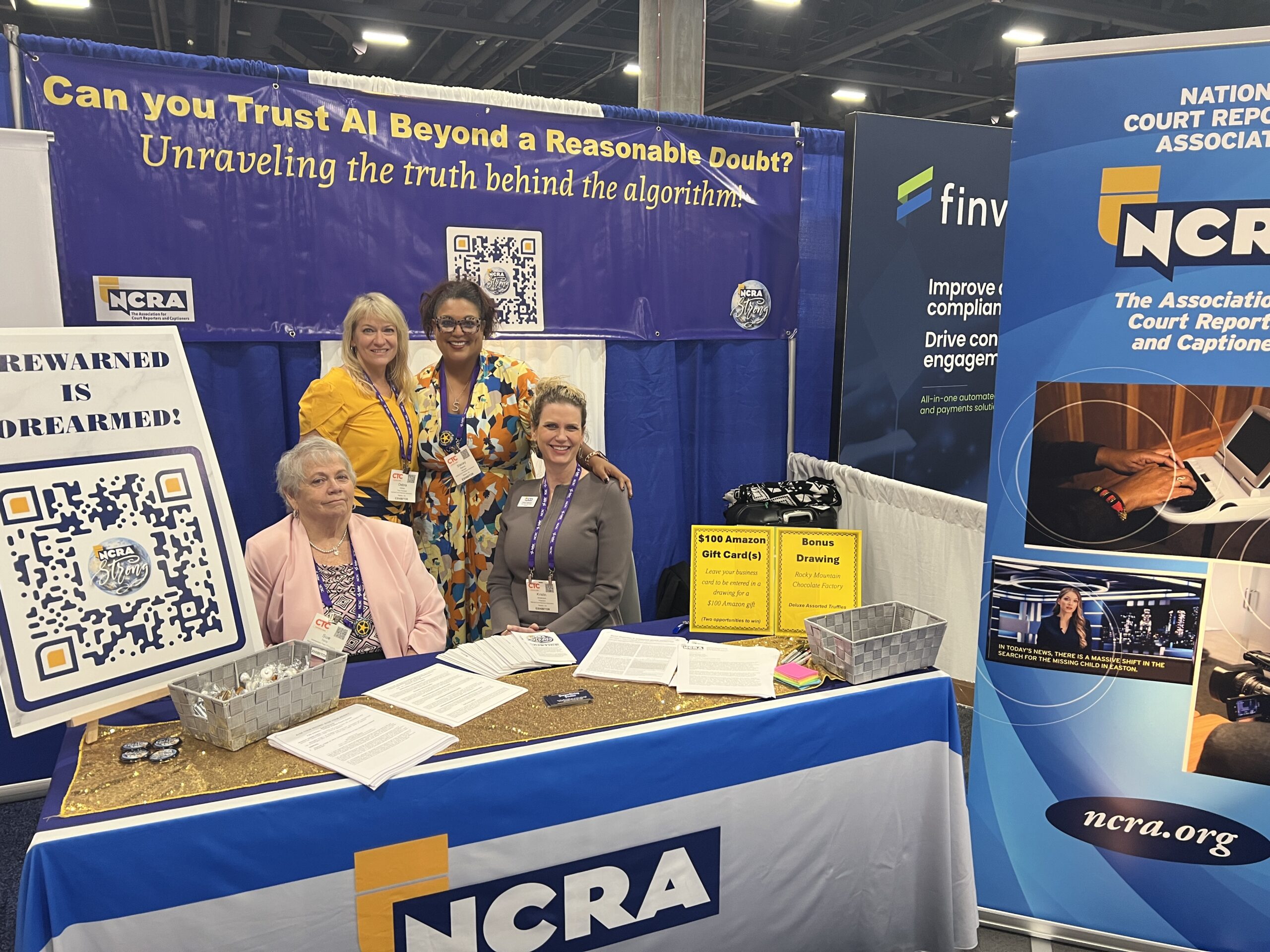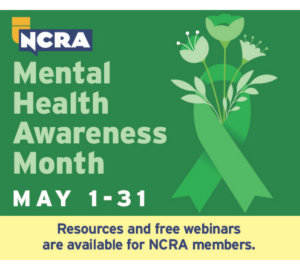By Debbie Dibble
The Court Technology Conference (CTC), a bi-yearly conference held in opposing years to the eCourts event, took place last week in Phoenix, Ariz. NCRA has had a booth in the vendor hall at this high-profile event for at least the past decade, and in a sage move by President Kristin Anderson, M.A., RPR, FCRR, and the NCRA Board of Directors, there was no deviation in 2023. This year’s CTC was unprecedented not only due to the highest attendance in two decades, but also because of the incredible opportunity it provided to NCRA members.
The 2021 NCRA Strategic Plan identified an incredibly important initiative of outreach to decision-makers in our industry, and this year’s NCRA representatives left no stone unturned. To begin, the NCRA booth was decorated in bright NCRA blue and gold with banners and visuals all designed to attract attention and offer the greatest return on investment through contacts with attendees. The NCRA booth was operated by a dynamic group of knowledgeable and engaging representatives: Stacey Raikes, RMR, CRR; Debbie Dibble, RDR, CRR, CRC; Sue Terry, FAPR, RPR, CRR, CRC; and President Kristin Anderson, and the group used all resources to both engage with the maximum number of contacts possible as well as to gather contact information from dozens of court professionals. The truth of the matter is that the opportunities could not have been more plentiful nor more perfectly designed for the NCRA message.
The opening session, entitled “The Five Most Complicated Things We Are Talking About Today,” focused almost entirely on artificial intelligence. While the overarching message was risks and complications created by AI in the judicial system, the obvious connection to protecting the record was undeniable and effectively seized upon by the NCRA CTC team. The team spent hours debating and preparing an effective banner to attract attendees and encourage visits to our booth. As we listened to the opening session address, we were giddy at the perfection of our final choice for a tagline. Miraculously — or merely intuitively — our banner read: Can you trust AI beyond a reasonable doubt? Unraveling the truth behind the algorithm! It was effective beyond our wildest imaginations. Over and over, individuals would pass by our booth, stop, read the banner, don a quizzical look as they processed, and then say, “I am intrigued!” It was truly unprecedented how the doors were opened wide for NCRA by the foundational, on-point segue created by the opening speakers’ presentation, a cacophonous symphony of risk followed by disastrous consequence from using artificial intelligence in the judicial system.
Keynote speaker Moira Gunn, Ph.D., delineated the concept of an Innovation Cascade with its four steps: innovation, user adoption, societal alarm, and finally to the creation of governing laws. She indicated we are vibrating madly between steps 2 and 3 as adoption opportunities are discovered and society revolts at the ensuing implications. Because of step 3, society demands controls and laws be enacted to try to achieve some level of control. This is the crucial step where NCRA’s involvement is imperative to ensure that the record is protected as lawmakers navigate the future, assess the potential dangers, and attempt to preserve the justice.
A few laser-focused remarks during the opening session left no doubt that the risks are real and the justice system needs to pay close attention and make wise decisions in this rapidly changing environment. To quote CTC leadership: “Whether an attorney, a judge, or a pro se litigant, all actors in the legal system have an obligation to protect legal certainty. While generative AI is capable of creating words … the courts have an obligation to protect the integrity of the process. Through professional rules of conduct to procedures and forms, the court can adopt enforceable obligations such as requiring notice or disclaimers when documents are based upon or can include AI-generated information. When viewed as a tool through the lens of justice and the rule of law, courts can adapt emerging technologies to advance justice, not to weaken or dilute the rule of law. You have the authority, you have the obligation, and you have the ability to navigate and advance justice in this era of rapidly changing technological advances.”
With a platform of such import, this was an excellent opportunity for NCRA, the likes of which we have never seen before. More than 900 attendees, including judges, court administrators and managers, IT personnel, chief information officers, judicial council members, and all manner of key roles in the legal process all focused on protecting the judicial system. The vendor hall, as usual, was replete with all manner of alternative methods that are vying for our role as guardians of the record using these very risky technologies. It would have been a monumental loss had our membership not been represented at this event.
The NCRA CTC team was not alone in this effort, as there were other NCRA members in attendance. They approached our booth and joined the brigade. Eric Allen, president of the Association of Surrogates and Supreme Court Reporters (ASSCR) Within The City of New York, is a steadfast representative for his membership, and he and his associate, Vincent Palumbo, RMR, CRR, can always be depended on to be at CTC and to join us in representing NCRA and our combined professional community. As Allen explained: “I attend the CTC conference because it is, in my opinion, important to understand what the courts are needing and what opportunities those needs can create for our membership, as well as to stay abreast of what vendors are ‘selling’ as alternative methods of creating a court record.
“I was elated to see NCRA committee members there as well, deeply engaged in setting facts straight to court administrators regarding the true dangers of relying on an electronic recording system or artificial intelligence. In fact, their vendor booth banner read: ‘Can you Trust AI Beyond A Reasonable Doubt?,’ and they were drawing large nonstop crowds of admins who were carefully listening to the pitfalls. As an NCRA member, this was particularly important and valuable to me, knowing our national association was there gaining more knowledge and spreading theirs to unknowing prey of AI and ER vendors,” Allen added.
NCRA had print material isolating cases being remanded or reversed due to inadequate records, discriminations and biases replete in artificial intelligence applications and digital failures. They disseminated information and spent hours discussing the disastrous consequences that will destroy public trust in the judicial system and how stenographic court reporters protect, preserve, and defend justice. A QR code was created as a quick access link to a repository for attendees, facilitating their future access to the information we shared, as well as to preserve NCRA dollars on printing costs. It was prominently displayed on a 20×30 board titled “Forewarned is forearmed,” as well as printed on small pass-out cards to obviate the need for handling extra items and unnecessary travel weight.
A preconference message was sent to all attendees the morning the conference began by saying: “There has been a lot about AI in the news recently. Visit us in Booth #405 to hear how Actual Intelligence protects justice!” That message was delivered as the keynote speaker was enumerating the risks of artificial intelligence to the legal process. The timing could not have been better. Finally, we sent a post-conference message to follow up with all attendees expressing our appreciation to those who visited our booth and including a link to the NCRA information repository to ensure we maximized the impact of every contact.
The NCRA booth was vibrant, eye-catching, informative, and staffed by knowledgeable and dynamic personalities to engage in thoughtful and meaningful discussions with decision-makers in our industry. President Anderson remarked, “This dynamic group of volunteers strategically, intelligently, and professionally advocated for our profession and our Association, continuing our journey this year of making every connection matter.” CTC 2023 was truly an opportunity of a lifetime for our NCRA membership.
JCR Contributing Editor Debbie Dibble, RDR, CRR, CRC, of Salt Lake City, Utah, is an NCRA Past President, member of the NCRA STRONG Committee, freelance captioner, and judicial court reporter. She can be reached at ddib06@gmail.com.





